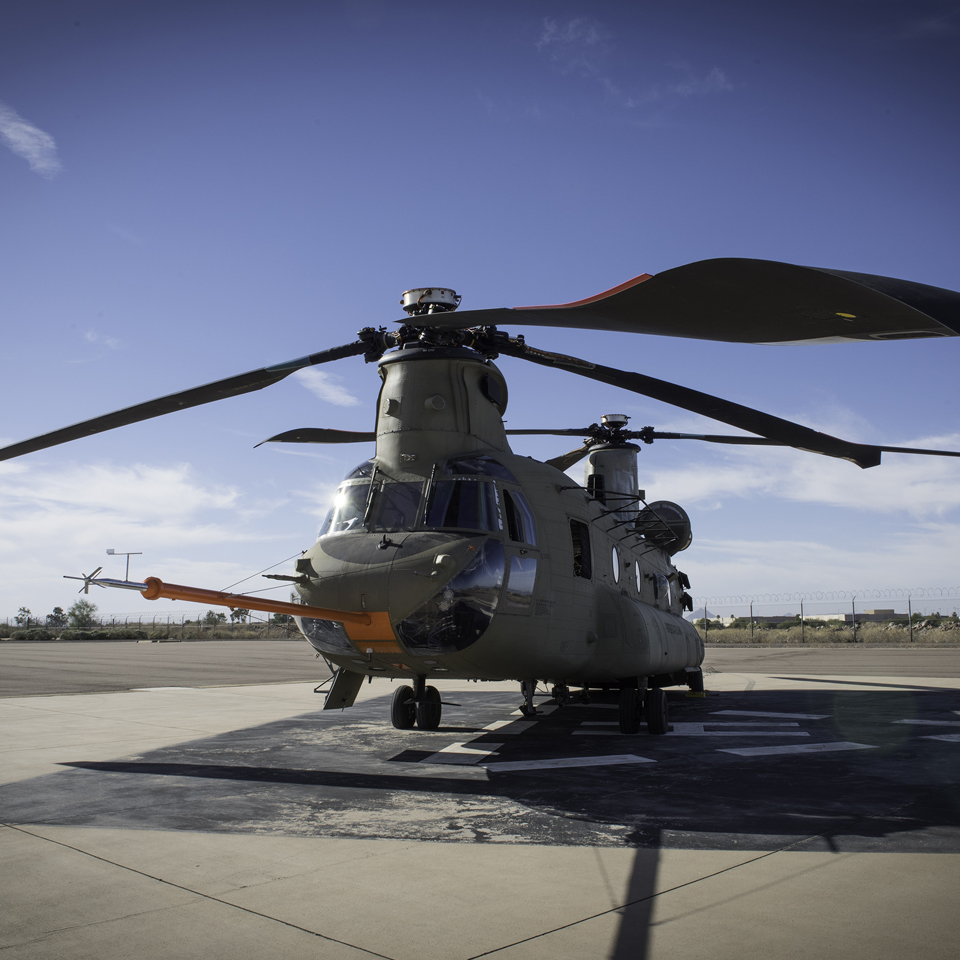Today’s heavy-lift helicopters must handle heavier equipment and climb to higher altitudes at hotter temperatures. With the Army not planning for a heavy lift program under Future Vertical Lift (FVL) any time soon as it focuses on the Future Long Range Assault Aircraft (FLRAA) and Future Attack Reconnaissance Aircraft (FARA) programs, Boeing and the Army have developed the Chinook Block II configuration to meet mission needs to include multi-domain operations.
To discuss this topic, we spoke with Pat Donnelly, director for CH47 Program Management, with responsibilities for U.S. military production to include CH-47F Block I, Block II, and MH-47G, which is a Special Forces variant.
Breaking Defense: Why does the Army need to modernize heavy lift.
Donnelly: The Army is modernizing its entire system with one of the major elements being Future Vertical Lift (FVL). Heavy lift is enduring and required no matter what the Army does so modernizing the Chinook, or modernizing heavy lift, is just part of it. New and modernized systems like vehicles and precision fires are getting heavier.
For example, the Joint Light Tactical Vehicle is much heavier when they start adding armor. The M777 155mm Howitzer is also heavier. In addition, the Army always wants to go further. That is putting a strain on the existing heavy lift capability to go to greater ranges, to carry more, and to operate at higher altitudes in more austere environments.
So the focus of our effort is to increase the payload and range of the Chinook and allow it also to operate at higher altitudes. The Army learned a lot from conducting hot and high missions in Afghanistan, which was an environment that they struggled with.
Certainly the Chinook is the heavy lifter for the Army. It is a transport vehicle that carries troops, equipment, and food, but unlike the C-130 or the C-17 that move bullets and bombs around, the advantage is that a helicopter doesn’t need a runway. So it is the last spoke. C-17s and C-130s can carry stuff so far, but it’s the helicopter that can take them to wherever the troops are operating.
The Chinook will continue to serve as the Army’s heavy lift helicopter for years to come. The Army has said that they need more lift, and the purpose of the CH-47F Block II is to deliver that lift and that modernization now – not 10 years from now.
Breaking Defense: What role will Chinook Block II play in multi-domain operations?
Donnelly: Right now we are the enabler for multi-domain operations. We can carry more troops and more critical cargo over longer distances. The Army wants to do precision fires, they want to have boots on the ground, and they want to have tactical vehicles running around the battlefield. They can’t do it without Chinooks moving and helping to facilitate multi-domain operations.
The Block II Chinook is a growth platform that gives the Army and Special Operations Forces the lift that they need today, and supports multi-domain operations into the future. The CH-47F Block II offers the familiar shape of the Chinook, transformed to offer more. It will excel at higher altitudes, carry heavier payloads and operate in hotter temperatures than ever before. That means greater capabilities, mission readiness, rapid response and efficiency in the multi-domain battle space.
Ultimately, all operations come down to imposing will with operations on the ground. The CH-47F Block II provides the required capability. Army Chief of Staff James McConville testified that F Block II is the capability they want. We are ready to provide that capability. During many of the hearings on Capitol Hill, there were discussions around INDOPACOM operations, as well, an environment in which the Block II configuration will thrive.

The new Advanced Chinook Rotor Blade features a swept-tip wing design that gives an additional 1,500 lbs-plus lift capacity to carry Army vehicles, weapons, and equipment.
Breaking Defense: What would the Army lose if it focused wholly on Future Vertical Lift and retired the Chinook?
Donnelly: Just for clarification about retiring the Chinook. When I hear the phrase “retire Chinook,” that to me takes the Chinook out of the Army’s inventory, which they have no intention of doing because they need heavy lift. The Army intends to replace the Black Hawk and the Kiowa Warrior under the FLRAA and FARA programs as elements of Future Vertical Lift.
Boeing not only agrees with, but supports the Army’s future vision. The acquisition of the Block II Chinook supports and enables that vision. Future Vertical Lift-Heavy is not planned for the near term. So the problem that the Army faces is that they would need to recapitalize the Chinook fleet that they operate today because they’re worn out as they did double duty in Afghanistan. A 2017 DoD Analysis of Alternatives stated that the Block II program saves over $3 billion long term compared to a CH-47F recap, which would be necessary. Those savings could be used to support FVL as those programs ramp up.
We have shown that we can give them 4,000 pounds more lift capability, and essentially recap them at the same time. We think we’ve proven that it’s an affordable, low-risk, Multi-Domain-Operations enabler, and the best thing for the Army to do is to modernize to a Block II configuration rather than recapping in the Block I.
Breaking Defense: Discuss the new Chinook Block II technologies and how each improves mission success: Advanced Chinook Rotor Blade, redesigned fuel tanks, strengthened fuselage, and improved drivetrain. How will these technologies help the Army exceed the capabilities of our adversaries?
Donnelly: The primary intent for the Block II is to increase payload and to reduce operating costs on the battlefield so that the Chinook can continue to be an enabler of Army operations well into the future. Each of our improvements address those goals.
The Advanced Chinook Rotor Blade, or ACRB as we call it, is the cornerstone that everyone is focusing their attention upon. We’ve added new air foils and a new tip shape that alone provides 2,500 pounds of additional lift to the Chinook. We’ve demonstrated that and proven it in operations at high altitude.
But it’s more than just blades. Take the re-designed fuel tank. The CH-47F Chinook has three separate tanks on each side of the fuselage. With Block II, we went to a single fuel tank on each side, and it’s proven very effective. By going to two tanks instead of six we’ve reduced the need for transfer pumps and eliminated a lot of plumbing. Taken together, we’ve reduced weight and added some more fuel capability.
We also stiffened the fuselage in the backend, so we can accommodate bigger engines and can increase the lift capability of the aircraft by 4,000 pounds.
In addition, we wanted Block II to have more in common with the Special Forces MH-47G model so the nose of both aircraft are now the same. If you were a Chinook aficionado, you’d notice that the G model has a longer nose because Special Forces have more equipment that they store in that region. But that made it unique and, as such, the G model in many instances had unique material. Going to a more common structure means the F and G models can benefit from greater interchangeability, creating more flexibility and saving the Army money.
The interoperability, common configuration, and technology roadmap bolstered by the Block II program provides tangible, data-driven cost benefits for the Army – conventional and Special Operators – and even the international community.
Something that Special Forces have struggled with is that they’ve been operating the Chinook at 54,000 pounds for many years now, putting more strain and stress on the drivetrain, transmissions, and hubs—so much so that the Army would not put them back in their own inventory. Now, with Block II also going to 54,000 pounds, the G model can take advantage of the drivetrain logistics that the Army uses.
Finally, we have an improved electrical system on the aircraft. It manages the electrical consumption better, and will let us support things like the tactical network. It’s more stable and efficient.
As Boeing continues to partner with the U.S. Army, we’ve already brought digital capabilities into Block II with how we designed the new airframe for a larger engine, should the Army need that in the future, and how we developed the electrical system. Our digital capabilities have also played a critical role in the simulators, allowing us to make faster improvements to mission systems and reduce pilot workload.
Breaking Defense: Please provide a Block II program status.
Donnelly: We’re currently executing the Engineering Manufacturing Development phase of Block II. We’ve finished the design and are validating the design through flight testing.
There are three F Block II aircraft operating today. Boeing is operating two of them in our flight test facility, in Mesa, AZ. The Army is operating one of the aircraft in their flight test facility in Huntsville, AL. We’re doing more air-vehicle flight-performance development in Mesa, and they’re doing a lot of system development.
We are wrapping up fatigue testing of the rotor blades, while the fatigue testing and static testing of all the other new components has been completed.
We are executing to the plan that the government has established for the operating envelope, validating that the helicopter can do a 30-degree bank turn at such and such a gross weight, for example. We’re plugging along through the flight-test cards with aircraft one and two. The third aircraft at Huntsville is doing a lot of other validation like validating the software. Now that we’ve introduced a new rotor blade, they’re validating the algorithm and making the changes necessary to accommodate any track and balance adjustments that may be needed in the future during operations.
Breaking Defense: Final thoughts?
Donnelly: We don’t want America’s warfighters going into battle without being able to exceed the capabilities of our adversaries. We certainly support the Army’s future vision, and we believe that the Block II is part of that future vision.
With Block II’s enhanced capabilities and performance, as well as allowance for future growth capability, they’ll always have the edge. Given the nature of the battle space of the future, that’s why America’s heavy-lift capabilities must continue to evolve.
Also, funding Block II enhancements to the U.S. Army Chinook fleet minimizes risk by limiting future sustainment costs. It also keeps a critical production line running, eliminating costs in the future.
To that point, funding of Block II upgrades sustains the industrial base. It ensures that key suppliers within the industrial sector can remain productive, safeguarding jobs, and supply chain readiness.
The Army has invested a lot in the Block II program. We want to keep it fully funded, and we think it’s a win-win for the Army, the troops whose lives depend on the Chinook, and the industrial base. Congress recognizes this. We have seen Congress adding money because they recognize the value that the Chinook brings to the table and why that needs to continue with the Block II.
"heavy" - Google News
August 11, 2021 at 07:20PM
https://ift.tt/3fPwURG
Taking Army Heavy Lift To Greater Range, Altitude, And Payload - Breaking Defense
"heavy" - Google News
https://ift.tt/35FbxvS
https://ift.tt/3c3RoCk
heavy
Bagikan Berita Ini
















0 Response to "Taking Army Heavy Lift To Greater Range, Altitude, And Payload - Breaking Defense"
Post a Comment